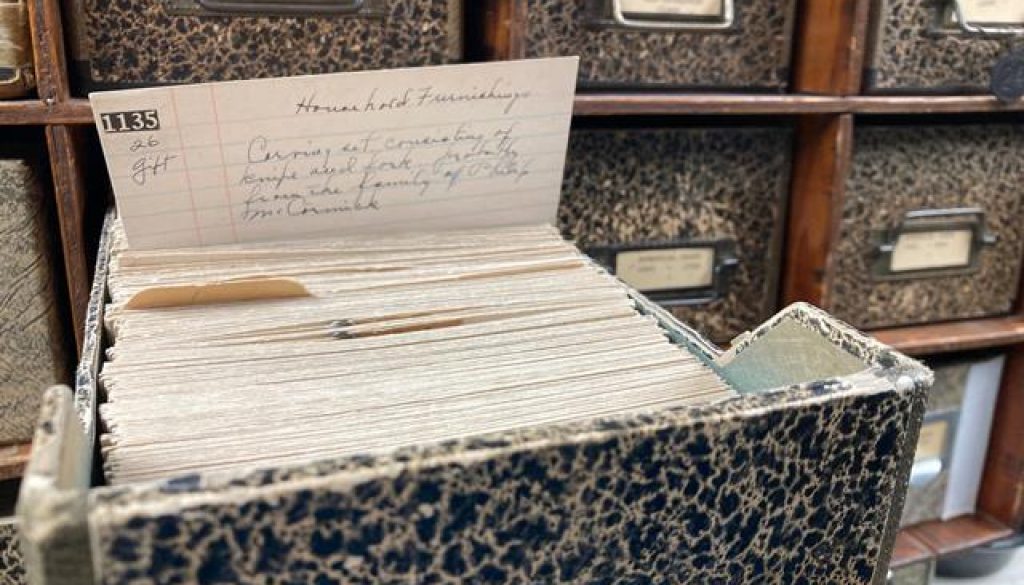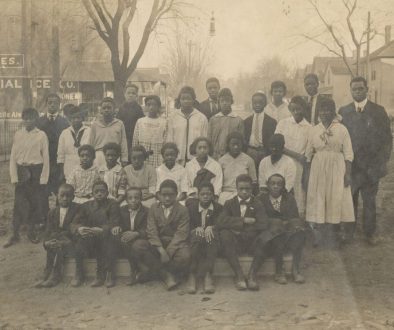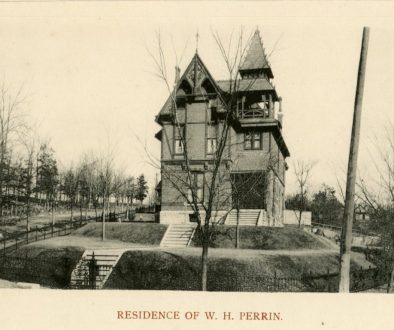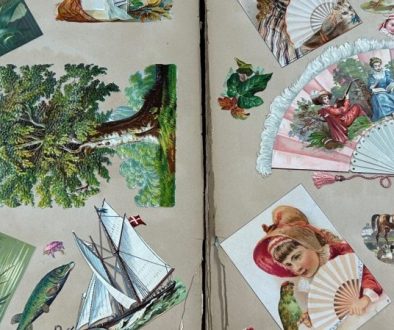Musings from the museum: Sixty years later
By Henry C. Pollock
Editors Note: This article is reprinted from an original article written in the 1980s by the son of TCHA’s first curator, Bird Pollock.
Moving Day used to be the first of May every year. Leases were made to start and end on this day. If one was going to move, this was the time of the year to do it and everyone did. Moving day was a day to remember, and although it wasn’t on the first of May, the first moving day for the Museum was a day I still remember.
My sister Harriet was working as a receptionist for Doctor C. B. Kern in his office on Columbia Street. Doctor Kern was one of those great family doctors that everyone loved and, though giving the impression of being just a country doctor, was far advanced in his method of child delivery and was one of the leading baby doctors in the area. The doctor’s wife, Flora Work Kern, was a real go-getter: small but mighty. She was a member of the Board of the newly re-formed Historical Society 1 which had as its chairman Doctor Richard Wetherill.
As a result of the Lafayette Centennial in 1925, a wealth of relics which had been displayed in store windows during the celebration were loaned or given to the Historical Association. These had been placed in rooms in the old vocational school at 6th and Columbia. The Historical Association, now growing in collections if not financially, decided that the Museum should be better organized, the items in the Museum cataloged, and things better arranged for display. It was decided that more help was needed to do this, and the search for a curator was on. Mrs. Kern mentioned this to my sister, and soon Mother presented her name to Mrs. Kern and the Committee. Mother was accepted and her work of 13 years as curator was started 2.
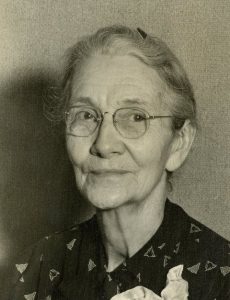
To a young boy of eleven, that old Museum was quite a gloomy and scary place. I can still remember being around the place while Mother was making out the hundreds of 3 x 5 cards for the permanent records of the Museum. She had beautiful printing and was very meticulous in making sure that the description, pertinent information, and ownership of the article was on each card. Many hours were spent making sure that everything in the collection was properly recorded.
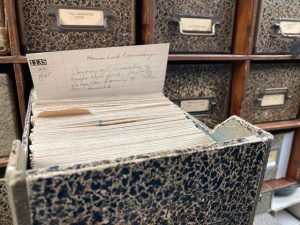
From time to time while I was visiting Mother and the Museum, a tall, very erect, distinguished man would arrive on the scene and tour the Museum and talk to Mother. This man, I soon learned, was Dr. Wetherill. Through the years he learned to know me as “little Mr. Pollock.” I was always in awe of this man who did so much for the Museum.
The collection of old dresses were displayed on manikins in big glass display cases- then hundreds of other items in flat cases. I was always dreaming up stories about these beautiful women and the gallant men who escorted them using the pistols in the collection to guard them.
One item in the collection which still stands out in my memory was a bust of Christ 3 which was back among the dress display cases, sitting on a pedestal. The bust had been placed in its location for no reason at all, but due to this location, at a certain time each day, a shaft of light would come through one of the high windows, striking and dramatically lighting this bust of Christ for a few moments, and then move on. I was duly impressed and used to try to be at the Museum at this time of day to see the illumination. I don’t think anyone else was impressed, but I felt it was great to think that this fellow Jesus could arrange to have the sun light his face once a day and make it stand out so vividly among all those gloomy exhibits in that poorly lighted room.
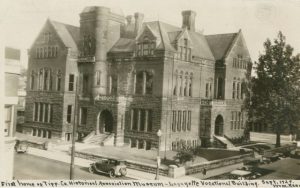
The collection continued to grow and the file of 3 x 5 cards that Mother made got bigger and bigger. Finally, in 1928, the rooms in the building on Columbia Street were filled to capacity, and no more articles could be accepted. What to do now? Things again looked bleak for this new museum.
Once again the dedicated Board of Governors did their work, and the Power that lighted that bust of Christ seemed to light their way, and they were pleased to announce that they had accepted the miraculous offer from David Ross to use the second floor of the Ross Building 4 on Main Street for the Museum.
Now we come to the day that I referred to in the first paragraph of this story: Moving Day. After months of planning and packing, the first things started arriving at the Museum. Several moving companies were engaged to help with this gigantic task. One of the companies was Ardapple with their big trucks and another was Lee Davis and Sons. The big display cases were brought up the wide front stairs, and the smaller boxes came up the iron back stairs from the large parking area at the rear of the building. The noise of the workers moving those heavy cases carefully up those front stairs seemed to be amplified as the sound reverberated along the halls and became almost a din.
The move was well organized, things were marked, and there did not seem to be too much confusion as to where cases and boxes were to go. Many hands made light work, and the continuous hollow sound of people coming up and going back down the iron rear stairs still echoes in my mind. I cannot remember how many days it took to complete this move, but it was finally completed, and the Museum was opened to visitors.
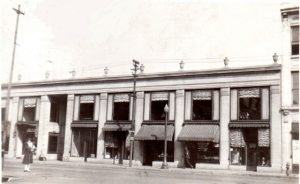
One incident of this move still stands out in my mind. One afternoon on a rather murky day I was watching Lee Davis coming up the rear stairs cradling very carefully in his arms that bust of Christ. Lee, who was well known around town as a kidder, looked down at the parking lot and spied his friend Hickory Ridmeyer. Holding the bust up for Hickory to see, Lee said in a loud voice, “Look up here, Hickory. This is probably as close as you will ever get to Christ.” Everyone had a laugh. A rather serious mood came across all of us, however, when at that moment a hole opened in the clouds, and a shaft of sunlight came through that hole and illuminated that bust of Christ! One of these days I will return to the Museum and look up that bust of Christ and watch very carefully for its illumination. Others may not see it, but I bet I will.
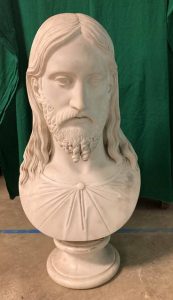
- The Tippecanoe County Historical Society was formed after the Lafayette/ Tippecanoe County Centennial Celebration in 1925. Several attempts at forming an historical society had already tried and failed. It was re-incorporated under a new name in 1928, the Tippecanoe County Historical Association. Flora Work Kern served as its first Vice President.
- Bird Pollock (Mrs. H. Y. Pollock) served as the first official curator of TCHA from 1926 to 1939.
- Marble bust of Jesus Christ which was formerly the property of Mrs. Mary L. Field of Philadelphia. It was presented by the sculptor to the United States Sanitary Commission for sale at a Fair in Philadelphia in 1862 for raising money for care of Union soldiers. It was not sold, but later was given to Mrs. Field in recognition of her great service to the Commission. It was donated to TCHA by Mrs. M. H. Liddell, daughter of Mrs. Fields. This item still remains in the collection of TCHA.
- This refers to the other Ross building on Main Street, located in the 600 block of Main Street, on the north side of the street.

